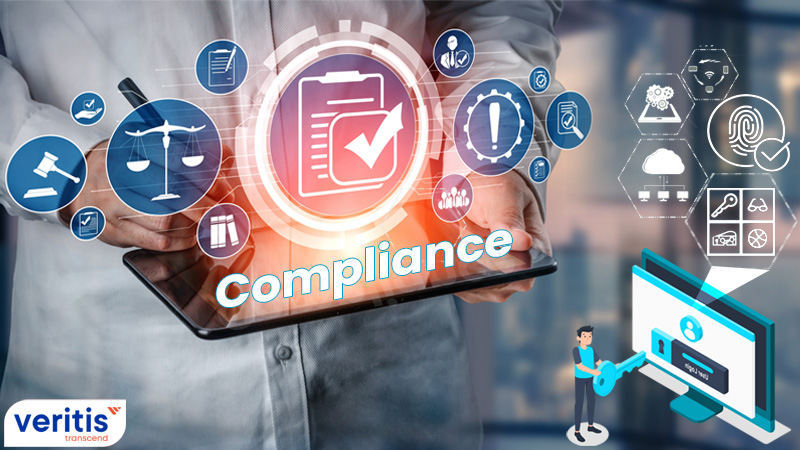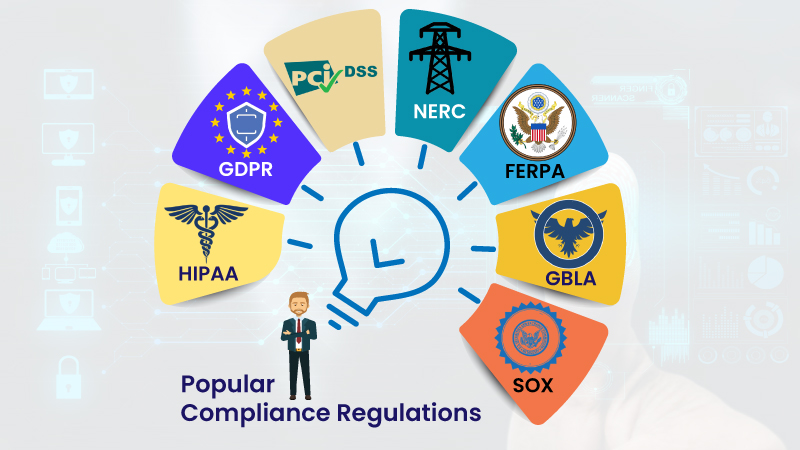
The growing cybersecurity landscape is presenting many threat incidents, posing severe risks to data and information security. Thus, in the current data-driven world, securing data has become the topmost priority for organizations and governments globally.
This gave rise to many industry-specific regulations aimed at ensuring data security and privacy. Now, complying with these regulations has become a serious challenge for many companies. These regulations impose high fines, penalties, and even regulatory-level punishments on firms failing to comply with the set rules. Thus, it’s imperative for every firm to meet these compliance regulations, and the Identity and Access Management (IAM) solutions can help you!
In the rapidly evolving field of Identity and Access Management (IAM) and regulatory compliance, recent statistics underscore the industry’s robust growth and its pivotal role in ensuring secure and compliant operations. According to a February 2023 report from Grand View Research, the global IAM market is projected to soar to USD 22.94 billion by 2027, registering a substantial Compound Annual Growth Rate (CAGR) of 13.2% from 2022 to 2027. Notably, the cloud-based IAM technology sector is emerging as a frontrunner, with predictions indicating a significant adoption rate of 64% by 2025, driven by scalability and cost-efficiency, as highlighted by KuppingerCole in their 2023 analysis.
Companies are increasingly recognizing the significance of the integral role of IAM technology in compliance. According to the Identity Theft Resource Center’s 2023 findings, 83% of organizations admit that IAM plays a critical role in their compliance strategy. However, the path to compliance is challenging, with Okta’s 2023 research revealing that 72% of companies struggle to demonstrate compliance, mainly due to manual IAM authentication processes. Furthermore, data breaches remain a significant concern, with the Ponemon Institute’s 2023 data indicating that 40% of such incidents involve privileged access misuse, underscoring the vital role IAM plays in access control.
IAM’s impact extends beyond general compliance to specific regulatory frameworks. For instance, IAM solutions are instrumental in aiding organizations with compliance with the General Data Protection Regulation (GDPR). As reported by IDG in 2023, 62% of businesses noted improved GDPR compliance following IAM implementation. In the healthcare sector, IAM is pivotal for Health Insurance Portability and Accountability Act (HIPAA) compliance, with HIMSS reporting in 2023 that 51% of healthcare organizations utilize IAM. Financial institutions also leverage IAM for compliance with the Payment Card Industry Data Security Standard (PCI DSS). Javelin Strategy & Research’s 2023 data indicates that 78% of these institutions find IAM crucial for enforcing strong authentication and access controls.
These statistics collectively paint a comprehensive picture of IAM’s burgeoning market, its critical role in IAM compliance strategies, and its tailored impact on specific regulatory domains, affirming its indispensability in today’s digitally driven and regulated business environment.
A robust IAM program, backed by an effective strategy and the ability to undergo successful audits, can boost your organization’s security posture and meet IAM compliance requirements. However, as the number of users, systems, and applications has multiplied in a typical enterprise IT environment, it has become increasingly challenging to maintain accurate and reliable data about every user on every system.
However, identity and access management systems can overcome this problem by automating user administration processes so that data about users can be maintained more efficiently and reliably.
Here, we bring you pictorial representations illustrating how identity governance and entitlements are managed with and without Identity and Access Management (IAM).
ALSO READ: 8-Point Identity and Access Management Audit Checklist
Role of IAM in Regulatory Compliance

In recent years, the imperative of complying with stringent security regulations has become a focal point for organizations, driven by regulatory authorities’ looming threat of penalties. Fortunately, Identity and Access Management (IAM) emerges as a formidable solution to navigate and streamline the complex field of identity and access management compliance. This explores IAM’s multifaceted role in ensuring adherence to security regulations and safeguarding organizations against potential penalties.
1) IAM’s Access Control Precision – Orchestrating Granular Permissions
IAM emerges as a pivotal force in the intricate dance of regulatory compliance, particularly when establishing precise control over data access. Regulatory frameworks often demand a meticulous delineation of who possesses access to sensitive data and who does not. IAM solutions step into this role with finesse, providing organizations with the tools for meticulous management and regulation of access permissions at a granular level.
2) Audit Trail Precision – IAM’s Vigilant Oversight for Compliance Assurance
Identity and access management systems control access and serve as vigilant guardians by generating detailed audit trails that chronicle user activities and log access attempts. These audit trails serve a dual purpose: substantiating compliance during audits and offering deep insights into network activities. IAM’s meticulous logging mechanisms simplify the process of identity and access management compliance verification and competence audits, reinforcing organizational vigilance and accountability.
3) IAM in Proactive Security Posture – Tracking and Responding to Threats
IAM tools are proactive in security regulations, constantly monitoring user activities, especially login attempts. This perpetual vigilance positions IAM authentication as a proactive guardian, enabling IT teams to detect suspicious activities and potential security breaches swiftly. IAM’s continuous monitoring empowers organizations to respond promptly to security incidents, aligning with regulatory guidelines on incident response.
4) Automated Provisioning and Least-privilege Principle – IAM’s Risk Mitigation Strategy
Identity and access management systems streamline user lifecycle processes, from creating accounts for new team members to instantaneously revoking access rights upon departure. Termed provisioning, this process is critical, and IAM authentication minimizes the risk by automating account management. The least-privilege principle embraced by IAM adds an extra layer of security, preventing unauthorized access to sensitive resources and reducing the vulnerability to internal data breaches.
ALSO READ: Top Tools and Security Protocols That Make IAM Successful!
Here, we will see the list of 7 popular compliance regulations and understand how IAM solutions help comply with them:

1) Health Insurance Portability and Accountability Act (HIPAA)
This compliance has national standards for processing electronic health transactions that demand secure electronic access to health data. It mandates to comply with the US Department of Health and Human Services (HHS) data and privacy regulations.
IAM helps in meeting HIPPA compliance requirements through well-defined identity governance and access management. Essential methods include single-on, multifactor authentication, password rotation, most minor privilege management, account provisioning, and de-provisioning.
2) General Data Protection Regulation (GDPR)
Introduced by EU, GDPR subjects organizations failing in compliance with penalties equaling 4 percent of their annual turnover. IAM technology can help organizations avoid GDPR penalties through:
- Identity Federation and ISO
- Identity Provisioning
- Identity Analytics
- Managing user consent on data tracking and retrieval
- Assisting user in exercising their rights to get data erased
- Notify user in case of a data breach incident
ALSO READ: Effective Identity and Access Management Implementation
3) Payment Card Industry Data Security Standard (PCI-DSS)
This is a security standard for companies involving credit card transactions. IAM can help meet this IAM compliance through data access management abilities. It uses the ‘least privilege’ principle of granting limited access.
IAM tools also applies identification management for non-registered users and administrators on system components by assigning unique IDs, revoking terminated users, and removing inactive accounts, among other ways.
4) North American Electric Reliability Corporation (NERC)
These standard mandates core cybersecurity-related technical requirements such as access control, authentication, reporting of electronic access to IT infrastructure, and segregation of duties.
Various NERC standards call for strict audits of electronic access. IAM solutions help comply with this regulation through access management, centralized control, and least privileges.
5) Family Educational Rights and Privacy Act (FERPA)
This standard is about identity governance access to student records and applies to all educational institutions and related agencies. This regulation requires organizations to confirm and authenticate parent identities to offer access to Personally Identifiable Information (PII).
IAM solutions help meet this regulatory by way of:
- Setting authentication levels by data vulnerability to risks
- Secure management of authentication information from creation to disposal
- Policy enforcement to avoid authentication misuse
- Management of user identities
6) Gramm-Leach-Bliley Act (GBLA)
This applies to financial institutions in safeguarding public information. This rule regulates the collection and disposal of public financial information and implements security protocols for securing the same.
IAM solutions can help meet GBLA through:
- Centralized Administration or Access Management
- Enforcement of Segregation of Duties (SoD)
- Access monitoring and modifications whenever required
- Revoking terminated access permissions
- Managing roles and access through the ‘least privilege’ principle
- Regular auditing of privileges and access rights
- Continuous tracking of account access for individuals
7) Sarbanes-Oxley (SOX)
This regulation applies to the BFSI sector and mandates that internal controls are implemented, tested, and documented for all activities involving financial information.
IAM solutions help meet these compliance requirements through:
- Centralized administration for managing access rights and authentication
- Strict enforcement of SoD policies
- Managing access rights upon changes
- Revoking terminated access rights
- Performing audits on access and rights at regular intervals
Conclusion
Veritis, a distinguished recipient of the Stevie and Globee Business Awards, is a leading IAM solutions and services provider, offering invaluable support to help your organization align with globally-reputed compliance frameworks. Our commitment to excellence has been demonstrated through a decade of service to numerous Fortune 500 firms within the US IT industry.
By choosing Veritis, you secure a robust IAM infrastructure and set a gold standard for your organizational information security posture. Suppose you seek support navigating the complex compliance domain and fortifying your cybersecurity measures. In that case, Veritis is your trusted partner in achieving and maintaining a resilient and compliant information security ecosystem.
Looking for Support? Schedule A Call
Also Read:
- Edge Computing Vs Cloud Computing: What are the Key Differences?
- All You Need to Know About Top 10 Security Issues in Cloud Computing
- What You Should Know About Containers Threats in Cloud Computing
- What is Generative AI: An Ultimate Guide to Amazon Generative AI Tools
- Cybersecurity Best Practices: Protecting Your Business from Data Breaches
- Developing a Robust IT Infrastructure Management to Support Business Expansion